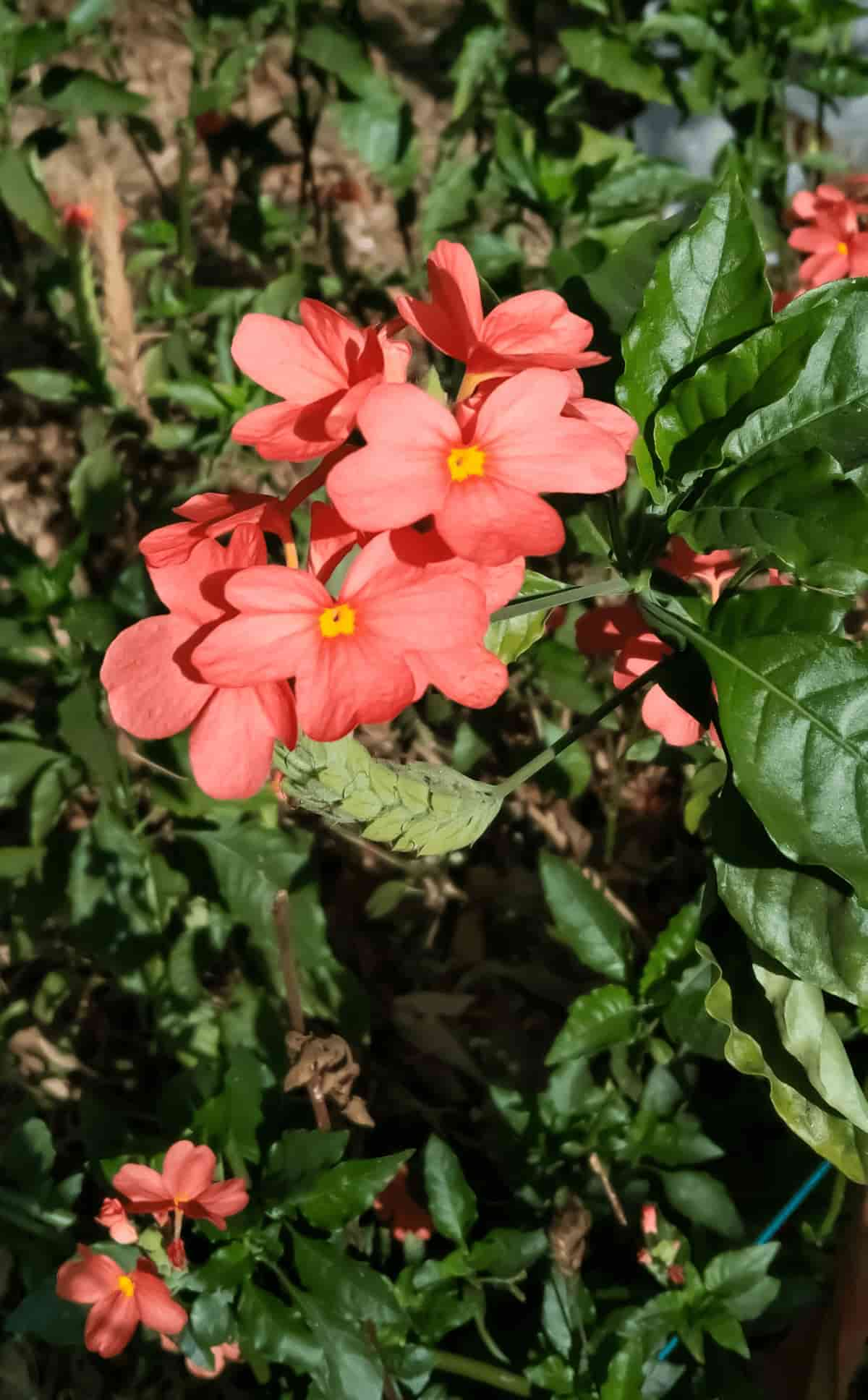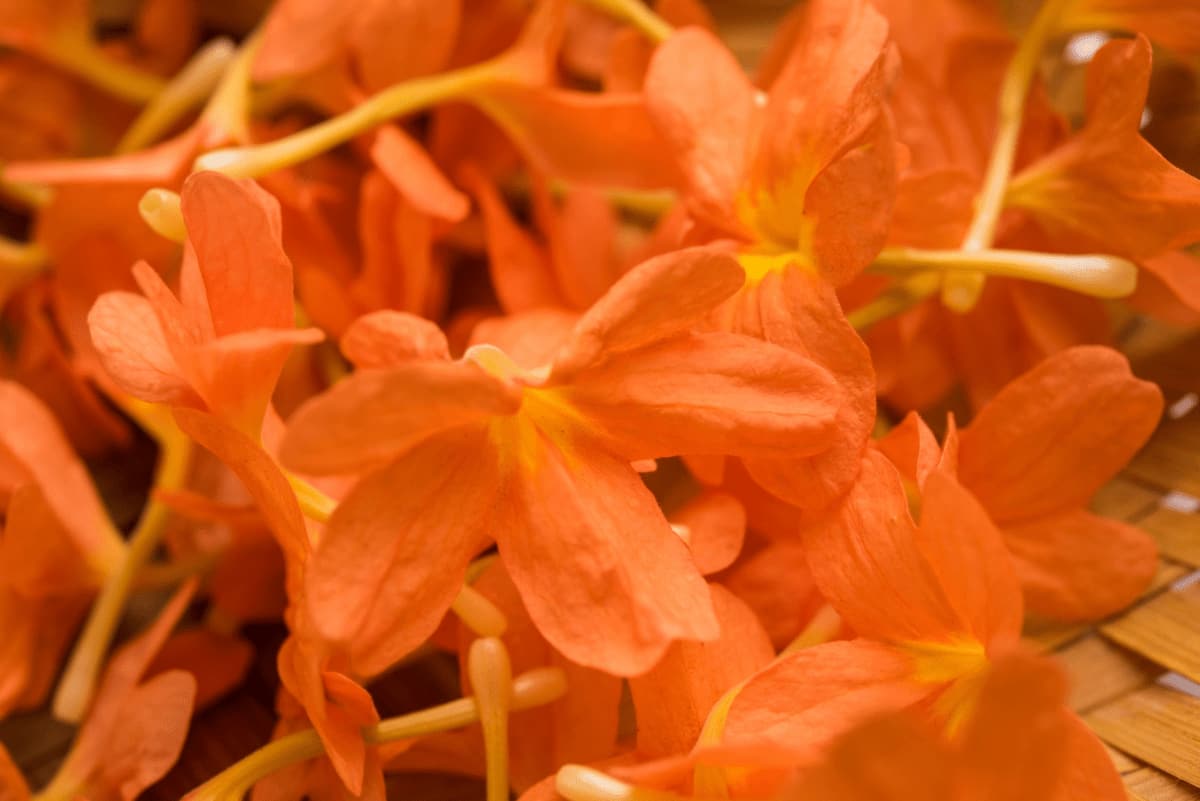The Firecracker Flower is another name for the Crossandra plant. It comes from Southern India and Sri Lanka. This tropical evergreen shrub captivates gardeners with its vibrant, enduring blooms and lush, glossy foliage. Providing adequate nutrients is critical for Crossandra to flourish with strong growth and abundant flowering. This article helps you learn the best fertilizers for Crossandra, the timing and application methods, and other care requirements, such as understanding the plant’s flowering season and deadheading practices.

Best Fertilizer for Crossandra
Understanding Crossandra’s Nutritional Needs
Like any plant, Crossandra has certain nutritional requirements that must be met to thrive. The three primary macronutrients vital to its health are nitrogen (N), phosphorus (P), and potassium (K). Nitrogen supports the growth of lush, green leaves, phosphorus aids in the development of roots and flowers, and potassium helps with water regulation and disease resistance.
Besides these primary nutrients, Crossandra also needs secondary nutrients and micronutrients, including calcium, magnesium, sulfur, iron, zinc, and manganese. These play an integral role in physiological processes like photosynthesis, respiration, and enzymatic activities.
The Best Fertilizer for Crossandra
Fulfilling Crossandra’s nutritional needs involves selecting a balanced, slow-release granular fertilizer with an N-P-K ratio of 14-14-14 or similar. This type of fertilizer provides a steady release of nutrients over a period, ensuring a constant supply of nutrients throughout the growing season. Moreover, it minimizes the risk of nutrient burn or over-fertilization, which could harm the plant.
An alternative to slow-release fertilizer is a water-soluble fertilizer with a comparable N-P-K ratio, such as a 20-20-20 blend. This type of fertilizer acts quickly and provides better control over nutrient application frequency and concentration. However, it requires more frequent application compared to slow-release fertilizers.
Maintaining Soil pH Levels
In addition to fertilizer application, monitoring and maintaining the soil pH is an essential step in Crossandra care. Crossandra prefers slightly acidic to neutral soil with a pH between 6.0 and 7.5. Crossandra may not obtain enough nutrients even with the proper fertilizer if the soil pH is too high or too low, which impairs the plant’s capacity to absorb nutrients from the soil.
You can test your soil’s pH using a soil test kit, which you can purchase from a garden center or online. Lime may be used to increase the pH of acidic soil (pH less than 6.0). If the pH level is over 7.5, acidifying agents like sulfur or peat moss must be added.
When to Fertilize Crossandra
Fertilization should align with Crossandra’s active growing season, typically during the warmer months of spring and summer. Fertiliser applications should be made throughout this time period, once every 4-6 weeks. Slow-release granular fertilizers should be applied every six weeks, while water-soluble fertilizers need application every four weeks.
In case you missed it: The Best Fertilizer for Marigolds: When and How to Apply

As Crossandra’s growth slows down in the cooler months of autumn and winter, you should reduce fertilization. During this period, apply fertilizer once every 8-10 weeks, or stop fertilization entirely if your plant is in a climate with consistently cool temperatures and low light levels.
How to Apply Fertilizer to Crossandra
Before applying fertilizer, follow the manufacturer’s instructions regarding recommended application rates and safety precautions. For slow-release granular fertilizers, you should measure the appropriate amount based on the size of your plant or container. Then, sprinkle the granules evenly over the soil surface, carefully avoiding direct contact with the plant’s stem.
Once applied, water the plant thoroughly to help the granules dissolve and distribute the nutrients throughout the soil. To use a water-soluble fertilizer, just dilute it with water in a watering can as directed on the packaging. Ensure you water the plant thoroughly so the fertilizer solution reaches the root zone. Apply this fertilizer solution every four weeks during the growing season.
Crossandra Flowering Season
Crossandra typically blooms from late spring through early fall. However, it can flower almost year-round with proper care and optimal growing conditions. During the blooming season, the plant produces clusters of vibrant orange or yellow flowers, which can last for several weeks. The continuous flowering of Crossandra is one of the traits that makes it a beloved choice among gardeners. Therefore, ensuring the provision of adequate nutrients during this period is vital to promote and maintain these colorful displays.
Deadheading Crossandra
Deadheading, or the process of removing spent blooms, is another important aspect of Crossandra care. This practice keeps your plant looking tidy and encourages more flowering. As Crossandra flowers fade, they can be pinched or cut off to prevent the plant from using its energy on seed production. The plant can produce more flowers by redirecting this energy, enhancing its overall appearance.
When deadheading Crossandra, use sharp, clean pruning shears or scissors to reduce the risk of disease transmission. Cut the stem just above the next leaf or bud to promote new growth. Make sure to wear gloves when performing this task, as the plant’s sap can be irritating to some people.
Incorporating Fertilizer into Overall Crossandra Care
While this article focuses on the best fertilizers for Crossandra, it’s worth noting that fertilizer is just one aspect of plant care. Crossandra also needs the right light conditions, regular watering, and appropriate temperatures to thrive. It does best in warm conditions (between 60 and 85 degrees Fahrenheit), with uniformly wet soil and bright, indirect light.
In case you missed it: The Best Fertilizer for Avocadoes: When and How to Apply

Pests and illnesses may also disrupt Crossandra’s vitality and blooming. Always keep an eye out for aphids and spider mites on your plant, and take immediate action if you see an infestation. Monitor for signs of disease, such as leaf spots or wilting, and adjust your care practices as necessary to prevent these issues.
Conclusion
Understanding and meeting its nutritional needs can promote strong growth and abundant flowering. Choose a balanced fertilizer and apply it correctly during the growing season to support your plant’s health. Additionally, take the time to deadhead spent blooms and provide the appropriate overall care for your Crossandra.
- Ultimate Guide to Ossabaw Island Hog: Breeding, Raising, Diet, and Care
- Ultimate Guide to Juliana Pig: Raising Facts, Size, Diet, Care, and Lifespan
- Raising Lleyn Sheep: Disadvantages, Price, Uses, Characteristics, and Care
- Ultimate Guide to Meishan Pig: Breed Facts, Breeding, Raising, and Care
- Ultimate Guide to Teacup Pigs: Raising, Diet, Lifespan, Cost, and Care
- Guide to Raising Poll Dorset Sheep: Facts, Profile, Characteristics, Uses, and Care
- Ultimate Guide to Bighorn Sheep: Characteristics, Diet, Lifespan, Breeding, and Lifecycle
- Ultimate Guide to Raising Katahdin Sheep: Farming Facts, Breed Profile, Uses, and Care
- Ultimate Guide to Raising Oreo Cows: Belted Galloways Farming Facts, Profile, Uses, and Care